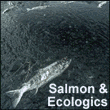forum
library
tutorial
contact

Current Findings Linking Plume and Ocean Conditions
to Salmon Growth and Survival
Ed CasillasScience Policy Exchange, September 12, 2007
|
the film forum library tutorial contact |

|
Current Findings Linking Plume and Ocean Conditions
Ed Casillas |
It is now recognized that throughout most of the 1980's and 1990's, ocean conditions in the Pacific Northwest region were poor, and ocean survival of Columbia River salmon was significantly affected. New insights now demonstrate that variations in salmon abundance are linked to phenomena on spatial and temporal scales that biologists and managers have not previously taken into account (the entire North Pacific Basin and decadal time scales). Over the past eight years we have demonstrated that the distribution, abundance, condition, and survival of juvenile Columbia River salmon vary synchronously with ocean conditions. Ocean conditions, in the context of salmon ecology, may be defined as that set of factors that control the growth and survival of salmonids during their life at sea. Those factors include for example ocean circulation, water temperature, upwelling, and the quality and quantity of the salmonid prey base.
Ocean conditions affect the abundance of piscine and avian predators of salmon and pathogens which can in turn affect salmon populations. Each of these factors varies in linear and non-linear ways at seasonal, interannual and decadal time scales. These findings have given us new insights into the climate-ocean linkages and mechanisms which influence marine survival of coho and Chinook salmon and steelhead.
Pearcy in 1992 proposed several mechanisms that might account for interannual variations in salmon survival in the plume habitat when they first enter the sea. He suggested that low river inflow is unfavorable for juvenile salmonid survival because of:
Related Sites:
Index of NW Council's Salmon Policy Exchange Presentations (Habitat, Mainstem, Estuary, Ocean Conditions)
learn more on topics covered in the film
see the video
read the script
learn the songs
discussion forum
